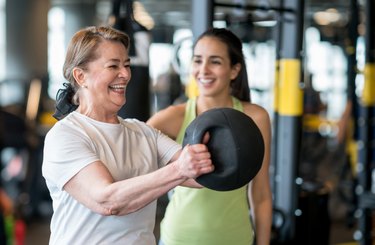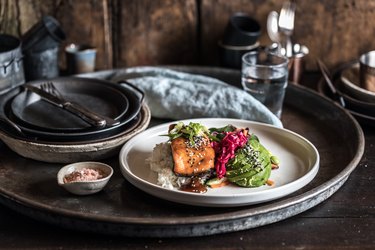
If you've every wondered why your arms are so fat, there are a number of potential reasons. But before you rush to lose weight in your arms, remember that it's OK — and quite normal — to carry extra fat in that area.
To help you better understand your body, here's what causes arm fat (including what causes fat upper arms).
Video of the Day
Video of the Day
1. Excess Body Fat
The reason why your upper arms are so fat may be because you carry excess weight, according to the Mayo Clinic.
Having excess fat can be the result of genetics, lifestyle habits like smoking, stress, lack of sleep, your diet and activity level, per the Mayo Clinic. While this won't lead to weight gain in your arms alone, it can contribute to carrying more weight throughout your body.
The best way to address it is to alter the behaviors that are leading to weight gain, namely eating a more nutritious diet and exercising regularly (more on that later).
Tip
Weight gain can also be a side effect of certain medications, hormonal conditions or thyroid problems, per Rush. If you're dealing with persistent weight gain and there's no good explanation, talk to your doctor to determine the cause.
2. Your Genetics
Have you ever wondered, "Why do I gain weight in my arms first?" Well, your genes may have something to do it with it.
Indeed, your genetics can, to an extent, predispose you to carrying more weight, according to Harvard Health Publishing. They can also affect your body fat distribution. As a result, the reason why your arms have excess fat may just be because you're more physiologically inclined to carry weight in that area.
3. Your Age
Age is another potential cause of flabby arms. Here's why arms get fatter with age: The amount of fat you carry naturally starts to increase when you're around 30 years old, according to the U.S. National Library of Medicine (NLM). This fat gain often occurs in your belly around your internal organs. Still, this can also contribute to weight gain in your arms.
Testosterone is a hormone that helps you maintain and grow your muscles and bones, according to Harvard Health Publishing. Though it's regularly associated with people assigned male at birth (AMAB), everyone needs certain levels of the hormone.
But testosterone levels decline as you age, which contributes to muscle and bone loss and potential weight gain, per the NLM. This could in part be what causes arm fat in all people as they get older.
4. You Have Loose Skin
Skin is an elastic and adaptive organ, so in cases of mild to moderate weight gain or loss, you may never notice loose or saggy skin.
However, in cases of rapid or extreme weight loss, you might notice some loose skin developing on your upper arms or anywhere else that you've lost the subcutaneous fat that had previously stretched out your skin, per the Cleveland Clinic.
In some cases, strength training can help you build muscle mass to fill out the excess skin. Other times, it may be best to talk to your doctor about whether skin removal surgery is the most effective solution, according to the Cleveland Clinic.
How to Lose Arm Fat
First things first, it's important to note that just because you have fat arms doesn't mean you need to lose that fat. Your body's natural weight may be what causes you to carry more upper arm fat, and that's totally OK. Besides, its normal — and essential — to have some fat on your body, per the Cleveland Clinic, including fat on your arms.
It's also crucial to understand that you can't target weight loss to one body part, according to the American Council on Exercise (ACE). In other words, you can't single out upper arm fat alone — you'll have to shed weight throughout your body to address fat upper arms.
If weight loss is your goal, though, it's best to focus on eating a nutritious diet, per the 2020-2025 Dietary Guidelines for Americans. This includes enjoying foods like:
- Fruits
- Vegetables
- Legumes like lentils, peas and beans
- Whole grains like spelt, buckwheat and oatmeal
- Beneficial sources of fat like nut butter and olive oil
- Proteins like fish, nuts and lean meats like chicken
- Dairy products like low-fat milk, yogurt and cottage cheese
It was once thought that cutting your calorie intake by 500 to 1,000 calories could help you lose 1 to 2 pounds of weight per week, but this hard-and-fast rule has been slightly debunked. Weight loss, instead, will also largely depend on factors like your body size, metabolism, genetics, underlying health conditions, etc., per the Mayo Clinic.
You can, however, still implement a combination of a balanced diet and exercise to burn calories.
Additionally, the Physical Activity Guidelines for Americans recommend doing at least 150 minutes of moderate-intensity aerobic activities per week (or 75 minutes of vigorous-intensity exercise), plus several strength training sessions.
Remember, the whole idea of spot reduction is a myth, so doing arm exercises doesn't magically burn fat from your arms. Instead, strength training your entire body can create muscle mass and tone everywhere, according to the Mayo Clinic.
And the benefits of exercising your arms (and the rest of your body) go far beyond the aesthetic. Strength training also builds stronger bones, burns calories, promotes strength and endurance for everyday activities, and can even improve your cognitive abilities, per the Mayo Clinic.
Tip
Any exercise that burns calories can help you lose weight, but the best workouts are the ones you enjoy enough to keep up in the long run, per the Physical Activity Guidelines for Americans. This will set you up for more sustainable changes.
- Cleveland Clinic: "Subcutaneous Fat"
- American Council on Exercise: "Myths and Misconceptions: Spot Reduction and Feeling the Burn"
- Harvard Health Publishing: "Calorie counting made easy"
- U.S. Department of Agriculture and U.S. Department of Health and Human Services: "2020-2025 Dietary Guidelines for Americans"
- U.S. Department of Agriculture and U.S. Department of Health and Human Services: "Physical Activity Guidelines for Americans"
- Mayo Clinic: "Obesity"
- Harvard Health Publishing: "Why people become overweight"
- U.S. National Library of Medicine: "Aging changes in body shape"
- Harvard Health Publishing: "Testosterone — What It Does And Doesn't Do"
- Rush: "Unexplained Weight Changes"
- Mayo Clinic: "Strength training: Get stronger, leaner, healthier"
- Cleveland Clinic: "Excess Skin Removal"
- Mayo Clinic: "Counting Calories: Get Back to Weight Loss Basics"
Was this article helpful?
150 Characters Max
0/150
Thank you for sharing!
Thank you for your feedback!


